2016 PEUGEOT 5008 sensor
[x] Cancel search: sensorPage 87 of 364
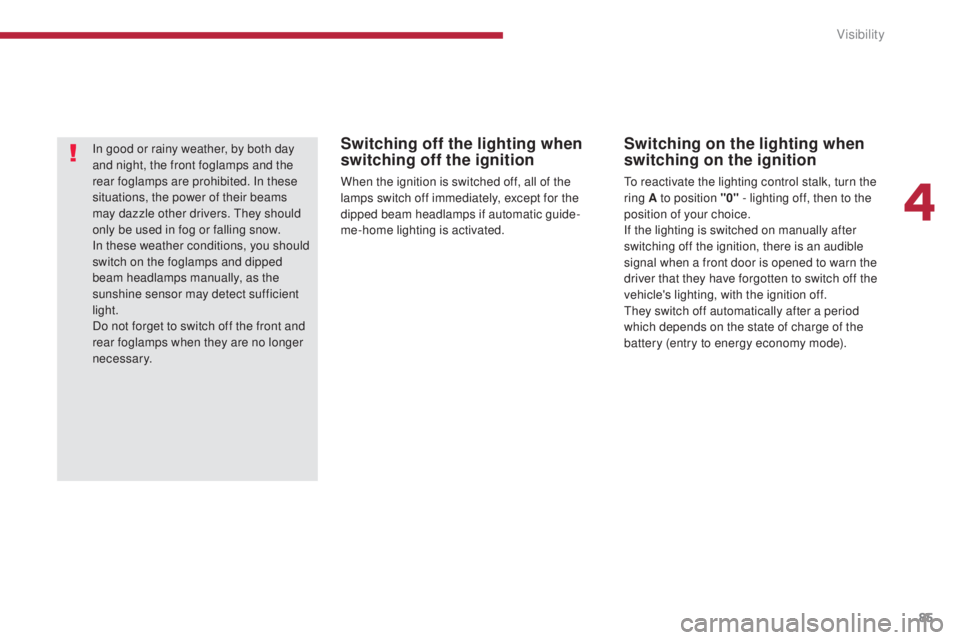
85
5008_en_Chap04_visibilite_ed01-2015
Switching off the lighting when
switching off the ignition
When the ignition is switched off, all of the
lamps switch off immediately, except for the
dipped beam headlamps if automatic guide-
me-home lighting is activated.
In good or rainy weather, by both day
and night, the front foglamps and the
rear foglamps are prohibited. In these
situations, the power of their beams
may dazzle other drivers. They should
only be used in fog or falling snow.
In these weather conditions, you should
switch on the foglamps and dipped
beam headlamps manually, as the
sunshine sensor may detect sufficient
light.
Do not forget to switch off the front and
rear foglamps when they are no longer
necessary.
Switching on the lighting when
switching on the ignition
To reactivate the lighting control stalk, turn the
ring A to position "0"
- lighting off, then to the
position of your choice.
If the lighting is switched on manually after
switching off the ignition, there is an audible
signal when a front door is opened to warn the
driver that they have forgotten to switch off the
vehicle's lighting, with the ignition off.
They switch off automatically after a period
which depends on the state of charge of the
battery (entry to energy economy mode).
4
Visibility
Page 88 of 364
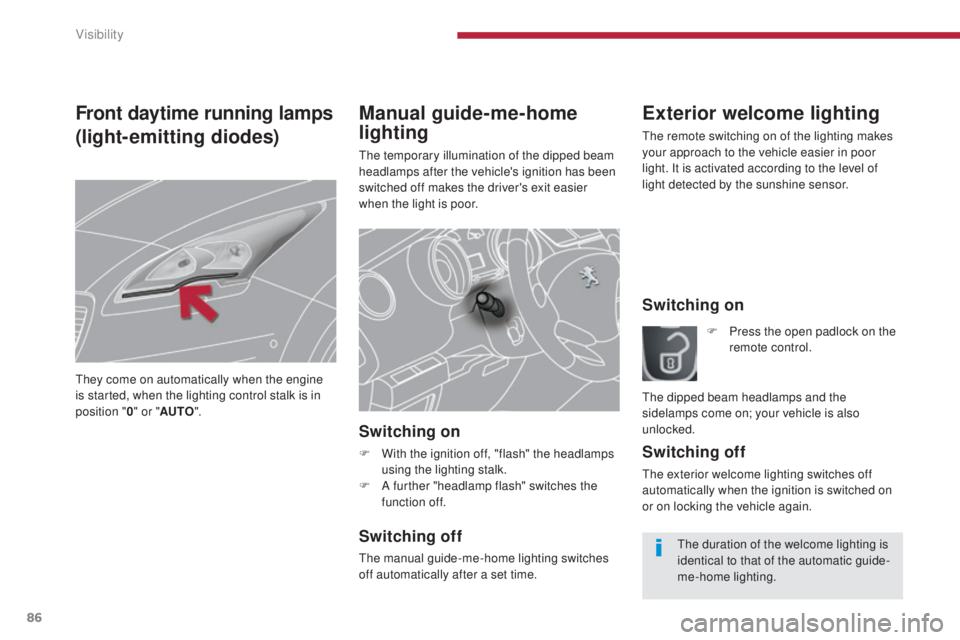
86
5008_en_Chap04_visibilite_ed01-2015
Manual guide-me-home
lighting
The temporary illumination of the dipped beam
headlamps after the vehicle's ignition has been
switched off makes the driver's exit easier
when the light is poor.
Switching on
F With the ignition off, "flash" the headlamps using the lighting stalk.
F
A f
urther "headlamp flash" switches the
function off.
Switching off
The manual guide-me-home lighting switches
off automatically after a set time.
Front daytime running lamps
(light-emitting diodes)
They come on automatically when the engine
is started, when the lighting control stalk is in
position " 0" or " AUTO ".
Switching on
Switching off
The exterior welcome lighting switches off
automatically when the ignition is switched on
or on locking the vehicle again. F
P
ress the open padlock on the
remote control.
The dipped beam headlamps and the
sidelamps come on; your vehicle is also
unlocked.
Exterior welcome lighting
The remote switching on of the lighting makes
your approach to the vehicle easier in poor
light. It is activated according to the level of
light detected by the sunshine sensor.
The duration of the welcome lighting is
identical to that of the automatic guide-
me-home lighting.
Visibility
Page 89 of 364
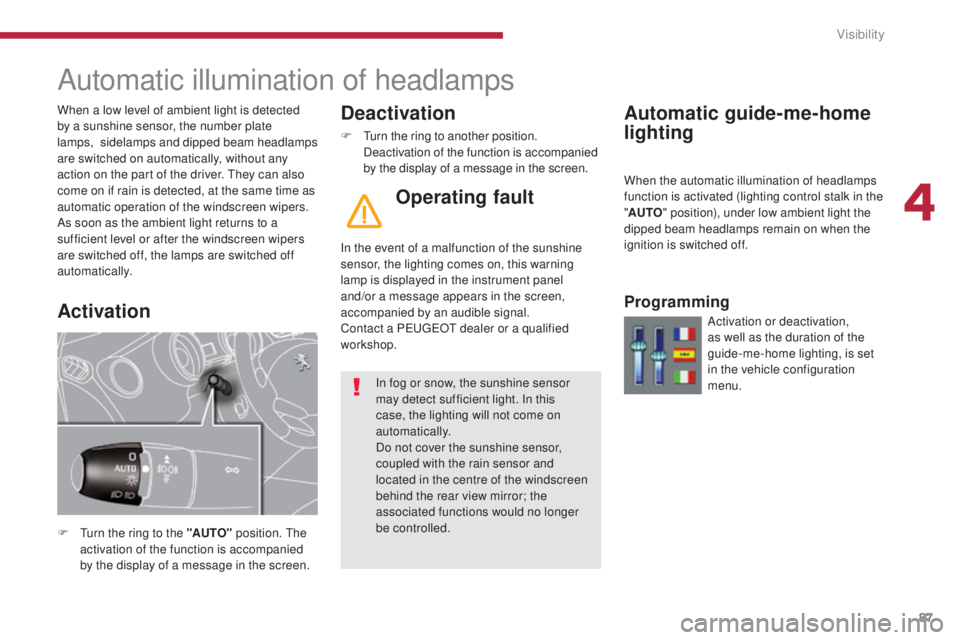
87
5008_en_Chap04_visibilite_ed01-2015
Automatic illumination of headlamps
F Turn the ring to the "AUTO" position. The
activation of the function is accompanied
by the display of a message in the screen.
Deactivation
F Turn the ring to another position. Deactivation of the function is accompanied
by the display of a message in the screen.
Operating fault
In the event of a malfunction of the sunshine
sensor, the lighting comes on, this warning
lamp is displayed in the instrument panel
and/or a message appears in the screen,
accompanied by an audible signal.
Contact a PEUGEOT dealer or a qualified
workshop.
Automatic guide-me-home
lighting
When the automatic illumination of headlamps
function is activated (lighting control stalk in the
"AUTO " position), under low ambient light the
dipped beam headlamps remain on when the
ignition is switched off.
In fog or snow, the sunshine sensor
may detect sufficient light. In this
case, the lighting will not come on
automatically.
Do not cover the sunshine sensor,
coupled with the rain sensor and
located in the centre of the windscreen
behind the rear view mirror; the
associated functions would no longer
be controlled.
When a low level of ambient light is detected
by a sunshine sensor, the number plate
lamps,
s
idelamps and dipped beam headlamps
are switched on automatically, without any
action on the part of the driver. They can also
come on if rain is detected, at the same time as
automatic operation of the windscreen wipers.
As soon as the ambient light returns to a
sufficient level or after the windscreen wipers
are switched off, the lamps are switched off
automatically.
ActivationProgramming
Activation or deactivation,
as well as the duration of the
guide-me-home lighting, is set
in the vehicle configuration
menu.
4
Visibility
Page 90 of 364
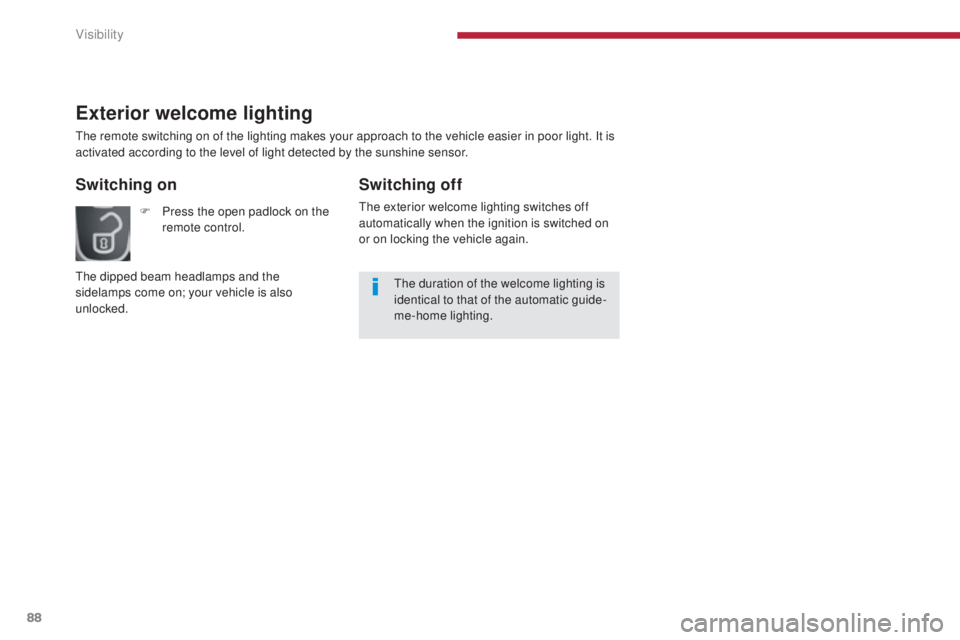
88
5008_en_Chap04_visibilite_ed01-2015
Exterior welcome lighting
The remote switching on of the lighting makes your approach to the vehicle easier in poor light. It is
activated according to the level of light detected by the sunshine sensor.
Switching on
The duration of the welcome lighting is
identical to that of the automatic guide-
me-home lighting.
F
P
ress the open padlock on the
remote control.
The dipped beam headlamps and the
sidelamps come on; your vehicle is also
unlocked.
Switching off
The exterior welcome lighting switches off
automatically when the ignition is switched on
or on locking the vehicle again.
Visibility
Page 96 of 364
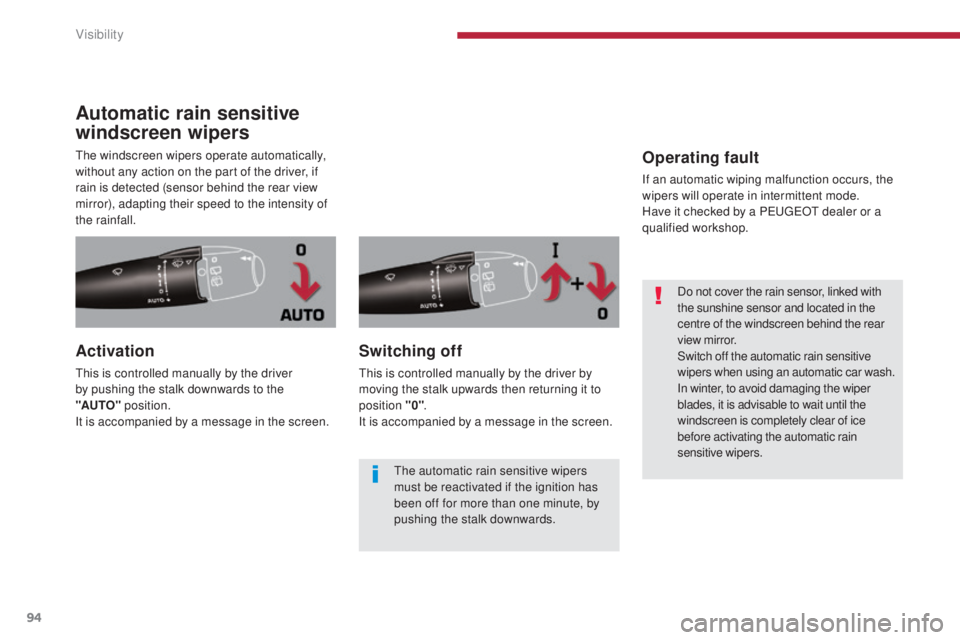
94
5008_en_Chap04_visibilite_ed01-2015
Automatic rain sensitive
windscreen wipers
The windscreen wipers operate automatically,
without any action on the part of the driver, if
rain is detected (sensor behind the rear view
mirror), adapting their speed to the intensity of
the rainfall.
Activation
This is controlled manually by the driver
by pushing the stalk downwards to the
"AUTO"
position.
It is accompanied by a message in the screen.
Switching off
This is controlled manually by the driver by
moving the stalk upwards then returning it to
position "0" .
It is accompanied by a message in the screen.
Operating fault
If an automatic wiping malfunction occurs, the
wipers will operate in intermittent mode.
Have it checked by a PEUGEOT dealer or a
qualified workshop.
Do not cover the rain sensor, linked with
the sunshine sensor and located in the
centre of the windscreen behind the rear
view mirror.
Switch off the automatic rain sensitive
wipers when using an automatic car wash.
In winter, to avoid damaging the wiper
blades, it is advisable to wait until the
windscreen is completely clear of ice
before activating the automatic rain
sensitive wipers.
The automatic rain sensitive wipers
must be reactivated if the ignition has
been off for more than one minute, by
pushing the stalk downwards.
Visibility
Page 164 of 364
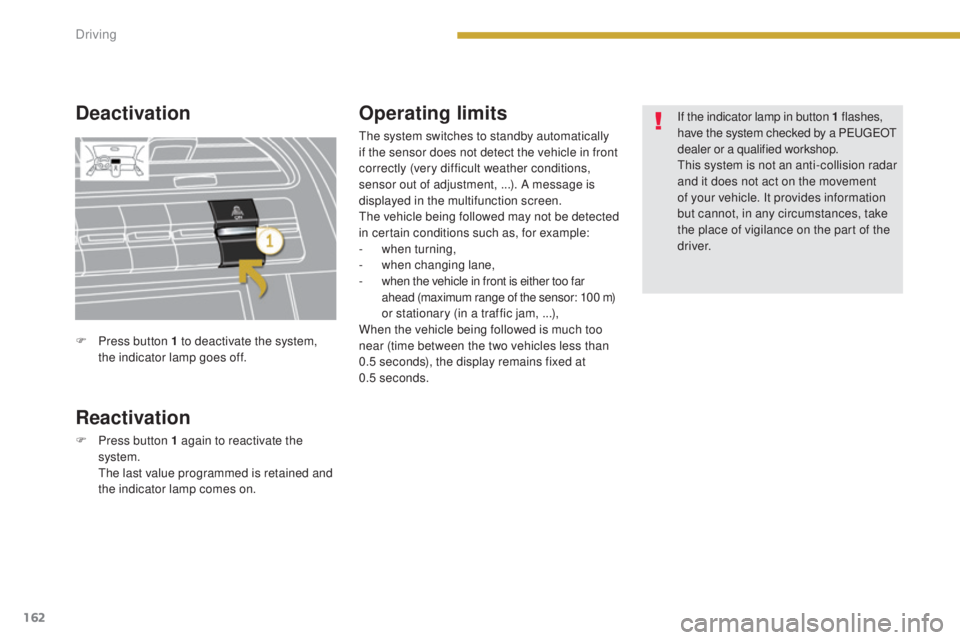
162
5008_en_Chap08_conduite_ed01-2015
Deactivation
Reactivation
F Press button 1 again to reactivate the system.
T
he last value programmed is retained and
the indicator lamp comes on.
Operating limits
The system switches to standby automatically
if the sensor does not detect the vehicle in front
correctly (very difficult weather conditions,
sensor out of adjustment,
...). A message is
displayed in the multifunction screen.
The vehicle being followed may not be detected
in certain conditions such as, for example:
-
w
hen turning,
-
w
hen changing lane,
-
w
hen the vehicle in front is either too far
ahead (maximum range of the sensor: 100
m)
or stationary (in a traffic jam,
...),
When the vehicle being followed is much too
near (time between the two vehicles less than
0.5 seconds), the display remains fixed at
0.5
seconds. If the indicator lamp in button 1
flashes,
have the system checked by a PEUGEOT
dealer or a qualified workshop.
This system is not an anti-collision radar
and it does not act on the movement
of your vehicle. It provides information
but cannot, in any circumstances, take
the place of vigilance on the part of the
driver.
F
P
ress button 1 to deactivate the system,
the indicator lamp goes off.
Driving
Page 185 of 364
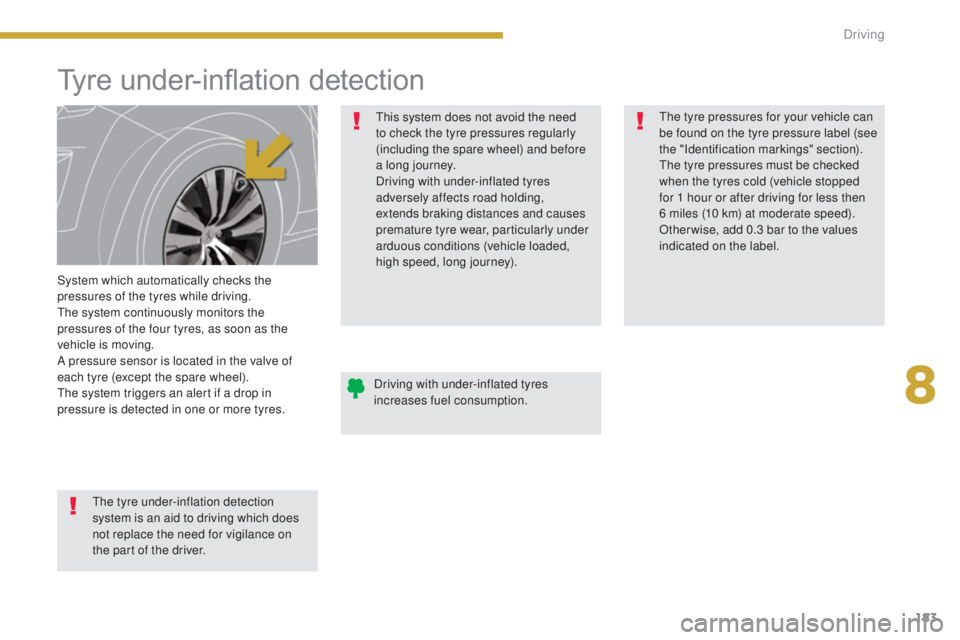
183
5008_en_Chap08_conduite_ed01-2015
Tyre under-inflation detection
System which automatically checks the
pressures of the tyres while driving.
The system continuously monitors the
pressures of the four tyres, as soon as the
vehicle is moving.
A pressure sensor is located in the valve of
each tyre (except the spare wheel).
The system triggers an alert if a drop in
pressure is detected in one or more tyres.This system does not avoid the need
to check the tyre pressures regularly
(including the spare wheel) and before
a long journey.
Driving with under-inflated tyres
adversely affects road holding,
extends braking distances and causes
premature tyre wear, particularly under
arduous conditions (vehicle loaded,
high speed, long journey).
The tyre pressures for your vehicle can
be found on the tyre pressure label (see
the "Identification markings" section).
The tyre pressures must be checked
when the tyres cold (vehicle stopped
for 1 hour or after driving for less then
6 miles (10 km) at moderate speed).
Other wise, add 0.3 bar to the values
indicated on the label.
Driving with under-inflated tyres
increases fuel consumption.
The tyre under-inflation detection
system is an aid to driving which does
not replace the need for vigilance on
the part of the driver.
8
Driving
Page 186 of 364
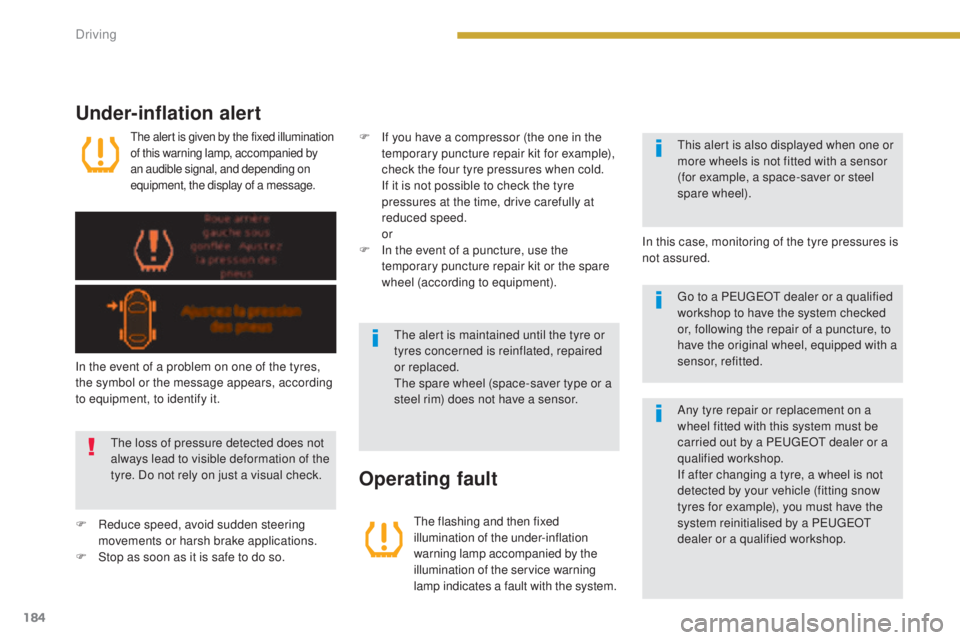
184
5008_en_Chap08_conduite_ed01-2015
The alert is given by the fixed illumination
of this warning lamp, accompanied by
an audible signal, and depending on
equipment, the display of a message.
Under-inflation alert
The flashing and then fixed
illumination of the under-inflation
warning lamp accompanied by the
illumination of the service warning
lamp indicates a fault with the system.
Operating fault
In the event of a problem on one of the tyres,
the symbol or the message appears, according
to equipment, to identify it.
F
R
educe speed, avoid sudden steering
movements or harsh brake applications.
F
S
top as soon as it is safe to do so.The loss of pressure detected does not
always lead to visible deformation of the
tyre. Do not rely on just a visual check. The alert is maintained until the tyre or
tyres concerned is reinflated, repaired
or replaced.
The spare wheel (space-saver type or a
steel rim) does not have a sensor.This alert is also displayed when one or
more wheels is not fitted with a sensor
(for example, a space-saver or steel
spare wheel).
In this case, monitoring of the tyre pressures is
not assured. Go to a PEUGEOT dealer or a qualified
workshop to have the system checked
or, following the repair of a puncture, to
have the original wheel, equipped with a
sensor, refitted.
F
I
f you have a compressor (the one in the
temporary puncture repair kit for example),
check the four tyre pressures when cold.
I
f it is not possible to check the tyre
pressures at the time, drive carefully at
reduced speed.
or
F
I
n the event of a puncture, use the
temporary puncture repair kit or the spare
wheel (according to equipment).
Any tyre repair or replacement on a
wheel fitted with this system must be
carried out by a PEUGEOT dealer or a
qualified workshop.
If after changing a tyre, a wheel is not
detected by your vehicle (fitting snow
tyres for example), you must have the
system reinitialised by a PEUGEOT
dealer or a qualified workshop.
Driving